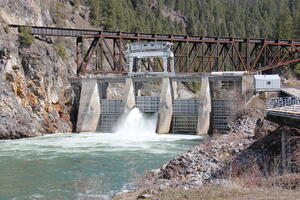 The aging of our transportation infrastructure gets most of the press these days, but often overlooked is the fact that our hydropower infrastructure is in the same state of decay. It’s an issue that won’t go away and that could lead to catastrophic consequences if not addressed. A pending wave of capital rehabilitation needs could be on the horizon. Will we be ready?
The aging of our transportation infrastructure gets most of the press these days, but often overlooked is the fact that our hydropower infrastructure is in the same state of decay. It’s an issue that won’t go away and that could lead to catastrophic consequences if not addressed. A pending wave of capital rehabilitation needs could be on the horizon. Will we be ready?To better understand the situation we’re in, it’s valuable to take a brief look at how we got here. In the late 1920's the crash of the stock market and the onset of the Great Depression left our country in dire need of a fiscal shot in the arm. That shot in the arm eventually came in the form of Roosevelt’s New Deal. In the Northwest, the New Deal led to numerous hydro, navigation, and irrigation projects. Between 1900 and 1983 over 125 small, medium and large hydropower plants were developed within the Columbia and Snake River basins. These plants supported the region’s need for cheap power and thirsty agricultural crops.
The heyday of hydro and irrigation expansion was curbed in the 1960’s by mounting fisheries concerns manifested by dwindling salmon returns. Environmental regulators pushed hydropower agencies to install fish bypass systems and to return rivers to a much more river-like hydrograph with higher run-off flows released in the spring and summer. Although positive for river health, this new paradigm had huge impacts on the region’s major power consumers, especially aluminum manufacturers, who eventually closed up shop in the NW.
Even though major industrial users left the market, the region grew and absorbed the lost demand. Our unique bounty of affordable and dependable hydropower continues to play an important role in the vitality of the West. Unfortunately, the majority of our hydropower infrastructure was built within a relatively short, 45-year period well over half a century ago. As a result, much of our existing hydro infrastructure is reaching the limits of its intended life and there is a huge need to reinvest in this important resource. The workforce that built, operates, and maintains this infrastructure is also aging quickly.
Currently, our largest hydropower producers - the US Army Corps of Engineers, Bureau of Reclamation, and the Bonneville Power Administration - have what appear to be extensive budgets, but those budgets are not enough to even keep up with deferred maintenance, let alone vital structural and operational improvements. There are also hundreds of privately held power facilities in the West with the same reinvestment needs. Can you feel the wave approaching?
Hydropower has played an important role in the development of the West and in the economic health of our country. There are many advantages to hydropower, however, the vitality of this industry will depend on answers to very difficult questions:
- How will we reverse the trends of decreasing reliability when there continues to be pressure on capital budgets?
-
Can we deliver much needed capital improvements given staffing restrictions and an aging workforce?
-
Are we in the hydropower industry prepared to deal with the pending wave of capital rehabilitation needs, or will that wave overwhelm us and wash us away?
As an industry, we must wrestle with these questions and find new and creative ways to fund and staff these important priorities. If we fail to do so, each one of us will feel the consequences. To quote the film Apollo 13, “Failure is not an option.”
I’m interested in hearing your thoughts on these questions and on the future of hydropower in the West. Contact me at 360-597-2638, I’d love to discuss with you how we can help provide solutions to your hydropower needs.

